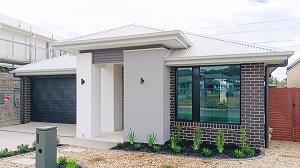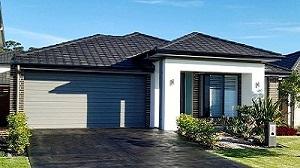As we move towards our target of net zero homes by 2050, it’s important to understand early what is required to meet the higher thermal performance and energy BASIX standards coming into effect from 1 October 2023.
Edgewater Homes and Henley Properties are making a head start. They recently reviewed their standard designs for 2 new houses in Oran Park, south-west Sydney, and explored upgrades needed to meet the higher standards.
The houses
Both houses are on standard rectangular flat blocks of about 350m2. They are typical single-level homes with brick-veneer external walls and timber internal wall structures lined with plasterboard. The slabs are waffle pods on reinforced concrete piers of various heights. The internal areas are between 154-163m2 excluding garages. Both homes have 4 bedrooms, 2 bathrooms and 2 garage spaces.
The key difference between the houses is their orientation. The rear of house 1 faces north-east, while the rear of house 2 faces south-west. The orientation of house 2 requires higher specifications to meet the higher BASIX standards.
|
|
|
| House 1 | House 2 |
Key design features to meet higher BASIX standards
| House 1: north-east rear aspect | House 2: south-west rear aspect | |
|
Energy |
|
Same as House 1, but no indoor clothesline. |
|
Thermal performance |
|
Same as House 1, except as below:
|
|
Water * |
|
Same as House 1. |
*The water standard is not changing from 1 October.
BASIX scores
House 1
Water: 44 (standard is 40)
Energy: 71 (standard is 70)
Thermal performance: Pass
House 2
Water: 43 (standard is 40)
Energy: 71 (standard is 70)
Thermal performance: Pass
Conclusions
While both houses needed upgrades to meet the higher BASIX standards, House 2 needed more significant upgrades.
For House 1, the estimated additional upfront cost to meet the higher BASIX standards was $10,100. This was based on a cost + builder’s margin model, reflecting real world cost implications.
Comparing the 2 houses shows how orientation affects the upgrades required. Being south-west facing at the rear, House 2 needs higher specifications to meet the thermal performance standards because:
- in winter, it receives less sun in the main areas of the house so higher specifications are required to reduce the heating requirements
- in summer, it receives the hotter westerly afternoon sun in the main areas of the house, so higher specifications are required to reduce the cooling requirements.
Additional upfront costs for thermal performance will maximise residents’ enjoyment of their home year round. Homeowners and tenants should be able to rely less on heating and cooling and see reduced energy bills.
Energy efficiency across climate zones
How to achieve higher thermal performance and energy BASIX standards in different NSW climate zones.
Read moreIncrease to BASIX standards
The NSW Government are improving BASIX standards to build more comfortable homes, cut energy costs and contribute to our target of net zero homes by 2050.
Read more

